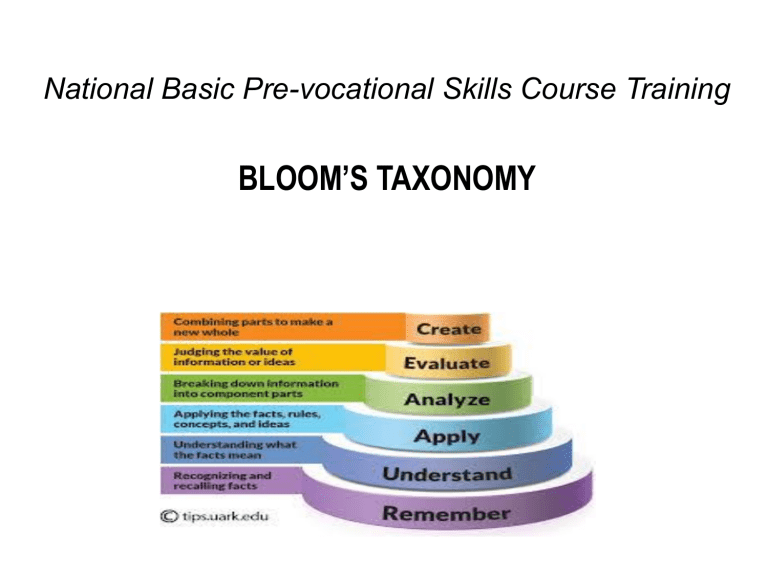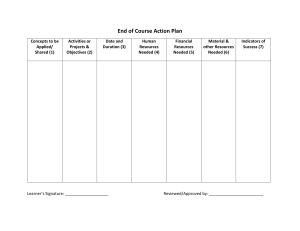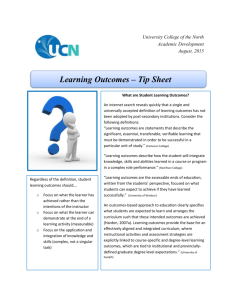
National Basic Pre-vocational Skills Course Training BLOOM’S TAXONOMY Objectives • Understand the use of Bloom’s taxonomy within respective subject areas. Bloom’s Taxonomy • Jewish-American Educational Psychologist , Benjamin Bloom • Classification of Educational Objectives and Mastery-Learning • Comes from Greek words • Taxis : arrangement • Nomos: science • Science of arrangements • Set of classification principles Bloom’s taxonomy is a classification system used to define and distinguish different levels of human cognition – i.e., thinking, learning , and understanding • Assessment • Curriculum: Syllabus, Lessons, Learning activities • Instructional methods Three Domains of Learning • Cognitive • Affective • Physical A. Cognitive Domain • Cognitive: mental skills (knowledge) • Recall or recognition of specific facts, procedural patterns and concepts • There are 6 major categories of cognitive processes • From Simple to complex Domains of Cognitive Level 1. Knowledge • Involves recall of specific and universals, methods and processes, patterns or structures • Questions to ask: What is…? • Can you select? • Where is…? • When did ____ happen? • Assessment • List the main characteristics of one of the main characters • Match statements with the character who said them. 2. Comprehension • Refers to understanding Questions to ask • What can you say about …? • How would you summarize… ? Assessment Draw a picture and/or write a sentence showing what happened before and after a passage or illustration found in the book. (visualizing) 3. Application • Refers to use of abstractions in particular and concrete situations Questions to ask How would you use…? • How would you solve ___ using what you’ve learned…? • What examples can you find to…? • How would you show your understanding of…? Assessment Make finger puppets and act out a part of the story. 4. Analysis • Breakdown of communication into its elements or parts • Questions to ask What are the parts or features of . . . ? • How is _______ related to . . . ? • Assessment Distinguish what could happen from what couldn't happen in the story in real life. Compare and/or contrast two of the main characters. 5. Synthesis / Evaluating • Involves the “putting together of elements and parts so as to form a whole” Key words: build, choose, combine, compile, compose, construct, create, design, develop, estimate Questions What changes would you make to solve…? • How would you improve…? What way would you design…? Assessment Use your imagination to draw a picture about the story. Create a new product related to the story. 6.Evaluation / Creating • Judgements about the value of the material and methods for given purposes Key words award, choose, conclude, criticize, decide Questions What is your opinion of…? How would you rate the…? Assessment Judge whether or not a brick should be built in this way. B. Affective Domain Affective Domain • Affective: growth in feelings or emotional areas(attitude or self) • Skills in describing how people react and their ability to feel livings things, pain or joy 1. Receiving • Lowest level whereby the learner passively pays attention • Example: Learner saws a person helping poor… 2. Responding • The learner is actively participating in the learning process, the learner reacts in some way • Example: He saw the people appreciating the person who helped the poor…. 3. Valuing • The learner attaches a value to an object, or piece of information. The learner associates a value or some values that requires knowledge • Example: He gives value that helping poor is an appreciable work… 4. Organizing • The learner can put together different values, information, and ideas and can accommodate them within his/her own schema, the learner is comparing, relating and elaborating on what has been learned. • Example: Than he organizes his learning that how he can help poor…. 5. Characterising • The learner at this level tries to build abstract knowledge • Example: At this stage the habit becomes the part of his character. C. Psychomotor • Manual or physical skills (Skills) • Focus is on change and/or development in behaviour or skills • Development of these skills requires practice and is measured in terms of... Measurements… • • • • • • • speed, precision, distance, Endurance, Flexibility Manipulation procedures, or techniques in execution Conclusion • Used as a teaching tool to balance assessment and evaluation questions in class, assignments • All levels of thinking must be exercise in learner’s learning Ms Regina Garises rgarises@nied.edu.na Tel: 062 – 509030 Cell: 081 2714037


